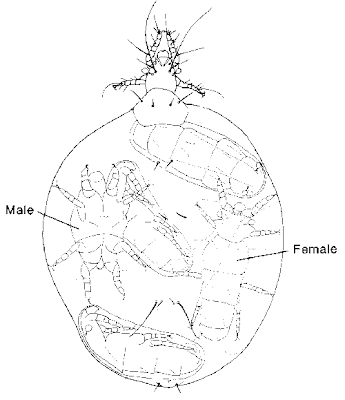 Previously I posted on aging in bacteria. One question I posed was "is, given an initial population that supposedly contains both old and young cells, are the differences in growth rate between cells sufficient to produce large differences in microcolony sizes when microcolonies are initiated on agar?" If true, this finding would have considerable bearing on the biology of an organism I am interested, the bacteriophage. Eric Stewart, author of the original manuscript I wrote about, responded to my question. Turns out there is not much reason to expect large differences in microcolony size due to cell age. However, other factors, such as whether the cell recently divided or not, could affect microcolony size. Here is what Dr. Stewart had to say:
Previously I posted on aging in bacteria. One question I posed was "is, given an initial population that supposedly contains both old and young cells, are the differences in growth rate between cells sufficient to produce large differences in microcolony sizes when microcolonies are initiated on agar?" If true, this finding would have considerable bearing on the biology of an organism I am interested, the bacteriophage. Eric Stewart, author of the original manuscript I wrote about, responded to my question. Turns out there is not much reason to expect large differences in microcolony size due to cell age. However, other factors, such as whether the cell recently divided or not, could affect microcolony size. Here is what Dr. Stewart had to say:
I did not record the size variation of the microcolonies, but even a two-fold difference is completely expected, based on the fact that some cells should arrive on the agar just after division, and some just before (a two-fold difference in starting biomass). Elio noted little variance in his colony sizes, and you wondered if old and new cells were different enough in growth rate to cause visible size differences in microcolonies. In fact, the very mechanism of how cells age (and rejuvenate) makes this almost impossible. Even a very old cell, as long as it can divide once, will produce one young cell in addition to its even older self. That young cell will have a nearly maximal growth rate, and should divide again relatively quickly, producing one more young cell, in addition to its now slightly older self. This means that as long as one division occurs, the colony is once again quickly populated with young cells, and eventually, at large enough population sizes, the entire 'standard' distribution of ages is recapitulated in every colony.
While the explanation above reduces the microcolony size difference due to the age of the starting cell, there are other factors at play as well. First, the difference in growth rates is something like 2% per old pole cell division, so if the cells are not extremely different in age, it will be very hard to detect, given the already two-fold variation in microcolony size due to the cell cycle timing of the first cell. Second, old cells are exponentially decreasing in frequency, by the very nature of the division that produces them. Young (first division) cells make up half of any E. coli population, due to the fact that one is produced in every division. The exact same process means that one half of the population is at least one division old, one quarter is at least two divisions old, 1/8th is at least three divisions old, etc. This means that in order to find one arbitrarily old cell, you must examine 2^X cells, where X is the division age you are seeking. As this doubles with each additional division, you can see that truly huge numbers must be examined to find really old cells. For example, examining about one thousand colonies will, on average, reveal one that arose from a ten division old cell; this would then need to be detected in the distribution of nine, eight, seven, etc. division old cells, taking into account the fact that the very first division produces a young cell, as noted above. Finally, there is a large amount of noise; that 2% difference is an average of very many cells. The distribution is quite
large.
For those reasons, it is quite difficult to detect senescence in bacteria. We accomplished it by examining very large numbers of cells, and measuring their actual individual growth rates (exponential fit to the increase in length over time). It was the automation that allowed us to achieve this; others had come very close in the past, but were limited by the need to measure and record all of the data by hand e.g. Powell EO and Errington FP. 1963. Generation times of individual bacteria: Some corroborative measurements. J Gen Microbiol 31: 315–327.
Dr. Stewart also responded to questions regarding the number of cells dying during the course of the experiments.
Elio Schaechter wrote that he spread Salmonella cells on nutrient agar on a slide, and counted how many didn't form colonies. This type of experiment was also performed by others (e.g. Gallant, J., and Palmer, L. (1979) Error propagation in viable cells. Mech. Ageing Dev. 10: 27-38), as well as repeated by myself before the timelapse experiments in the paper. Counting 17,000 microcolonies, I found a 'failure to grow' rate of about 1 in 400 for E. coli, which agreed with the Gallant and Palmer results as well. I suspect that there may be a 'plating shock' that results in such relatively high levels of non-growth, compared with the different measurement of non-growth during timelapse, which came out at about 1 in 2000. Therefore, this rate probably doesn't indicate much about senescence, but some other cause of 'death' (non-growth).
So there you have it. Cells age. But you have to check quite a few cells before you notice much of an effect.
Photo of Bacillius subtilis by Dr. Leendert Hamoen, Institute for Cell and Molecular Biosciences, University of Newcastle upon Tyne.
 I love reading bioephemera; Jessica always has interesting things to say about biology and art (and her artwork is amazing). I was impressed at the insight in her latest post. It taught me a thing or two about detachment and human nature. Don't take my word for it, get over there and read it.
I love reading bioephemera; Jessica always has interesting things to say about biology and art (and her artwork is amazing). I was impressed at the insight in her latest post. It taught me a thing or two about detachment and human nature. Don't take my word for it, get over there and read it.







